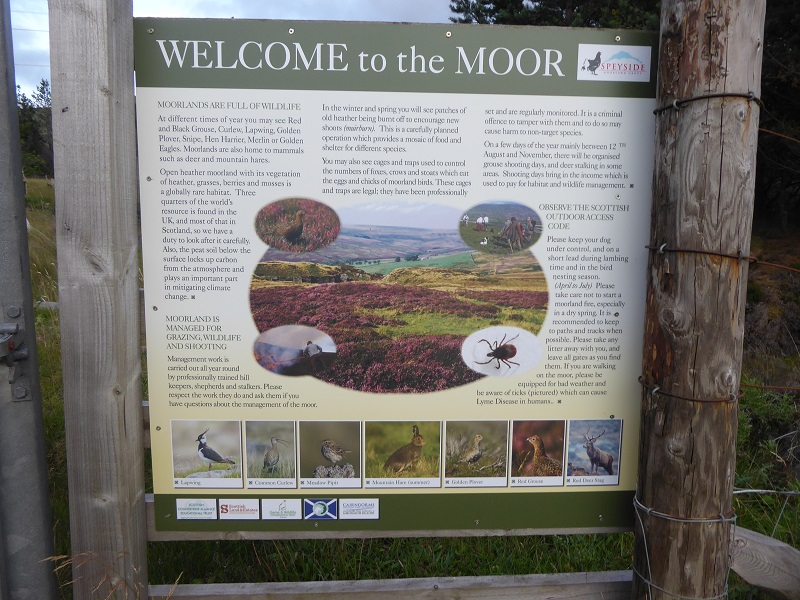
Increasing numbers of a new version of the “Welcome to the moor” sign are now being erected across Scotland, particularly in the Cairngorms National Park, but so far have received, as far as I am aware, little critical comment.
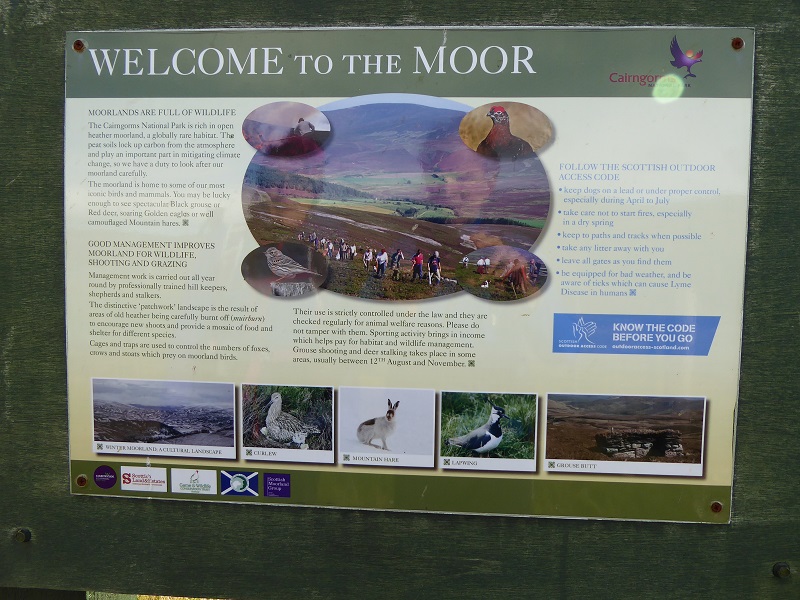
When is a welcome not a welcome?
I have no problem with people being welcomed to moorland, in fact the more the better, but included in both versions of the Welcome to the Moor sign under the section on the Scottish Outdoor Access Code is a rather significant qualification “It is recommended to keep to paths and tracks when possible”. So, people are not really being welcomed to the moor, only to paths and tracks, a small percentage of total moorland.
Now I was involved in drawing up the Scottish Outdoor Access Code (SOAC) and the only place it says that people should keep to paths and tracks is the section on privacy where it advises people to keep to a path or track – if there is one – when passing people’s houses. The whole point of the access legislation is it gives people a right to roam, whether on paths or off-paths. While no detailed guidance for grouse moor has been developed under the SOAC, detailed guidance was produced for deer stalking – after endless discussion and debate between recreational organisations and landowners – and that is very clear:
“Any requests (to avoid certain areas) should relate to specific days and apply to the minimum necessary area – this is more likely to encourage a positive response than a longer-term and more general message”.

The furthest official guidance goes on deer stalking is to say that when stalking is actually taking place, “you can help by using paths, following ridges and following the main watercourse if you have to go through a coire” (see left). Contrast this with the Welcome to the Moor signs. They recommend people remain on paths and tracks at ALL times. The implication is that if you ignore the recommendation, you are being irresponsible. Even for people who are fully aware of their access rights, ignoring such signs creates a feeling on unease – will someone challenge you if you go off path?
There is no justification for the “recommendation” on the sign. Driven grouse moor shooting takes place on only a few days of the year and model signage has been produced to inform walkers that shooting, like deer stalking is in progress. The Welcome to the Moor sign makes no reference to the use of temporary signs to alert walkers when shooting is taking place because to do so would be to undermine the general message which is the public should stick to the path. The hypocrisy is these same estates are allowing vehicles, which do far more damage, to be driven willy nilly across grouse moors.
It is significant that these signs have not been endorsed by the National Access Forum and the latest version does not include the SOAC logo. So why is the Cairngorms National Park Authority, which is the statutory access authority and has a duty to protect access rights, lending its name to an initiative that is trying to undermine access rights?
The conservation benefits of grouse moors?
Its worse than that though. The first heading “Moorlands are full of wildlife” is for much of the Cairngorms National Park – and particularly where these signs are being erected – a lie. A few years ago I started wondering if I was missing something about grouse moor managers claiming moorland is good for wildlife – I would describe myself as a bad bird watcher – and deliberately went for a number of walks over moorland wildlife watching rather than walking up hills. Apart from red grouse and meadow pipit I have seen very little.
There is a reason for that and its got very little to do with my wildlife obervation skills. There is very little to see. In the September edition of Scottish Birds, the journal of the Scottish Ornithologists Club, there was an excellent article about the Lammermuirs which received national publicity (see here). Its not just about raptors, since the 1980s waders have declined as much as merlin, while grey partridge and short-eared owl had disappeared completely, the sound of the cuckoo was much rarer, while on the burns common sandpiper and dipper were hard to find. In addition, the authors found young ring ouzel appeared to have a fatal attraction to traps. I believe these findings are equally applicable to the Cairngorms.
As evidence for this (the exceptions prove the rule) you could do no better than read the Glen Tanar estate blog (see here) – and thanks to Raptor Persecution Scotland for the tip-off. The descriptions of stoat hunting hare are fantastic. What a brilliant estate! Unfortunately your chance of seeing stoats or raptors in much of the National Park is minimal.
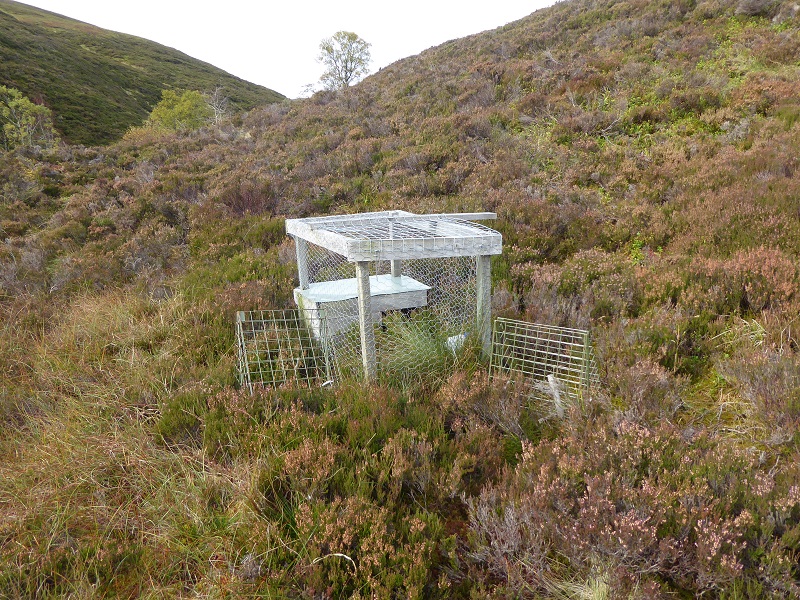
The reasons for this are twofold. The first is that any wildlife that is perceived as impacting on Red Grouse numbers is being systematically exterminated on most grouse moors in the National Park by a variety of means including trapping. That trapping is becoming a very political issue is seen by the claims last week (see here) by the Scottish Gamekeeper Association that visitors have been tampering with traps. The real question is not this – if its happening I can understand why people are angry enough to do so – but why our National Parks allow ANY trapping of wildlife? And if you think that is radical, its worth reading this comment from the Raptor Persecution Scotland blog (link above) that the UK is the ONLY country in the EU to still allow Fenn traps (the traps you find in the wire cages that are placed on logs across streams to catch stoat and weasel):
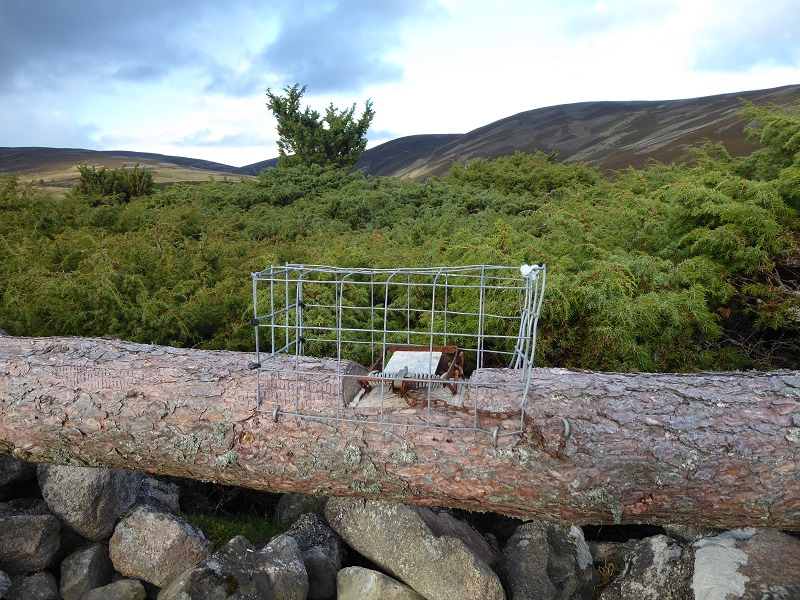
Almost all shooting estates, and predominantly grouse shooting estates, use Fenn Traps. These diabolical traps should have been outlawed in the UK in July last year but the UK government was the only EU country to seek a derogation of implementing the ban for two years. These traps have been banned in the rest of the EU, Canada, the USA, and Russia and negotiations on the International TREATY have been taking place since the 1990s. The ban in the UK should have been enacted under the AIHTS (Agreement on International Humane Trapping Standards) which outlaws traps which do not kill the ‘target’ animal within a certain time period (depending on the species) and by crushing the skull. Fenn Traps do not meet the criteria. In October 2015 Defra commissioned animal research into possibly two traps to determine whether these traps met the criteria. The research finished in February 2016 and the report of the results was given to the government just before the ban deadline. Defra claim there are no traps which meet the criteria which have been drawn up before any new traps can be approved for use with stoats (the animals they are allegedly used to ‘control’ In the UK on grouse moors. I have been waiting and repeatedly waiting for a copy of the report since July 2016 which is supposed to be released ‘soon’ ‘shortly’. In the meantime Defra have held Ministerial meetings about this international agreement with all the usual brigade (GWCT, BASC, NFU, NGA, MA, CA etc) but no animal welfare groups (or rather Defra identifies the establishment that carried out the lethal animal research as the animal welfare representative group!). All these groups and MPs with pecuniary interests in the shooting industry have held meetings with Defra and Ministers about the AIHTS for years. A key meeting with about 20 individuals and pro-shooting groups was held in January 2016 which was attended by Senior Defra officials. Following the meeting, Defra officials worked with some of the lobbyists to draw up an action plan for derogating the Agreement. Despite repeated FOI requests, Defra claims that no minutes of that meeting to discuss compliance or non compliance with an International Treaty were taken by Defra officials and none of them took notes! The GWCT have confirmed to me that their representative chaired the meeting and one of their group took the minutes of the meeting. They are refusing to release them to me and Defra claims not to have received copies of the minutes of this important legally crucial meeting so they cannot release them!
There is a link between the signs telling people to keep to the path and the persecution of wildlife in our National Parks. Most grouse moor managers just do not want the public to see what is going on. It won’t be long until landed interests start calling for access bans from grouse moors to preserve the rural way of life. The best thing anyone who cares about wildlife in our National Parks can do therefore is to leave the path, record the wildlife you see (for example on birdtrack) and record traps and other signs of wildlife persecution.
The second reason why you won’t see much wildlife in our National Parks is because of the way heather is promoted above all other plants, partly through moorland drainage but mainly through muirburn.
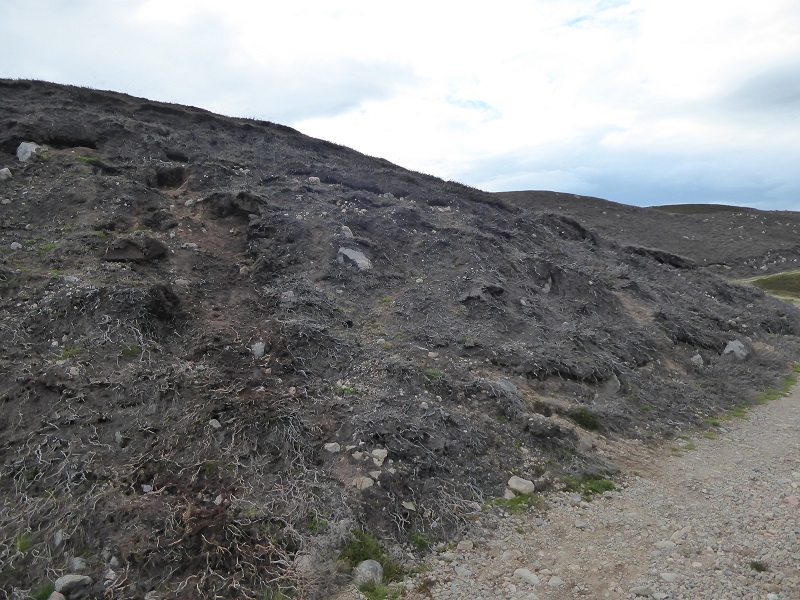
The only reason moorland is a rare habitat globally, as stated in the Welcome to the Moorland sign, is that no other country allows land to be managed in this way and yet we continue to do so, even in National Parks. On the one hand the Welcome to the Moor sign claims moorland is an important carbon store, in the next its describing muirburn which releases carbon. The sign claims muirburn is a carefully planned operation when in fact its highly disputed and contentious. The evidence for this can be seen in the new Muirburn Code which was issued in September:
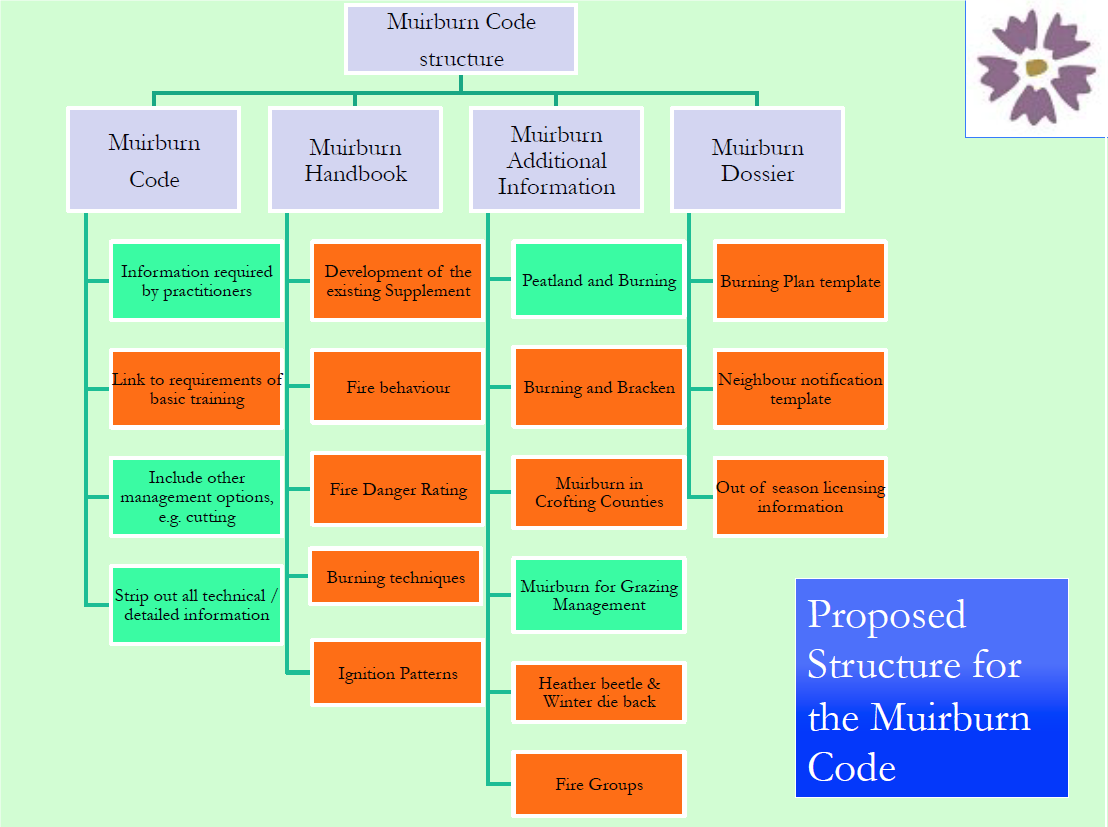
In relation to the Cairngorms National Park, one might ask how the CNPA’s endorsement of these signs compatible with what is has said about moorland management during the development of the National Park Partnership Plan:
- Controlled muirburn reduces the fuel load and can reduce the likelihood of spread of wildfires. Poorly managed muirburn can lead to destruction of rare habitats, carbon emissions, impact on water quality and creation of wildfires. A more selective approach would provide increased habitat biodiversity by leaving areas of scrub around the moorland edge, rather than managing simply in terms of either forest or moorland. (The Big 9 issues report).
- In some places however, the intensity of management measures to maintain or increase grouse populations is out of balance with delivering wider public interest priorities
- During the course of this Plan period we seek to establish, deliver and promote a shared
understanding of what good moorland management looks like in the Cairngorms National
Park. There is national guidance and current initiatives such as the revised muirburn code, and
the Principles of Moorland Management. We will work with moorland managers and all relevant
interests to agree what practical implementation of these means in a Cairngorms context and to
deliver greater public benefits alongside other estate management objectives.
There was nothing in the Partnership Plan to say heather moorland was a globally threatened habitat yet the CNPA has endorsed a sign which says just that. There is nothing in the signs which says the estates concerned have made any commitment to change the way they manage grouse moors so the implication is the CNPA is endorsing the way these estates are managed at present, which involves muirburn, bulldozing of tracks, persecution of wildlife.
What needs to happen?
The CNPA by endorsing these signs is in effect endorsing the intensive type of grouse moor management, which it says it wants to move away from, and undermining access rights. The CNPA keeps trying to say its caught between landowners and conservation and recreation interests and needs to take a middle way. However, when when push comes to shove it appears to end up supporting landowner interests rather than the rights of the public.
What is should do is tell the sponsors of this sign, Scottish Land and Estates, the Scottish Countryside Alliance Education Trust and the Game and Wildlife Conservation Trust that it will no longer support these signs and that the message about access needs to be changed to make it clear that people are welcome all over grouse moors. If necessary, it could work with recreation interests and the National Access Forum to apply existing guidance under the SOAC to grouse moors so grouse moor managers are absolutely clear about what is acceptable.
Meantime I think the only signs the CNPA should be associated with are on estates like Glen Tanar which do respect the vast majority of wildlife and try to manage the land in the way the CNPA set out in their Partnership Plan.

These signs are a clear breach of the access rights secured under the Land Reform (Scotland) Act 2003. The right to roam over moorland areas applies to the whole moor, not just to paths and tracks. This was agreed in the National Access Forum in preparation for the 2003 legislation, in the debates in the Scottish Parliament and in the wording of the Scottish Outdoor Access Code which was endorsed by the Parliament. All the land managing organisations which have produced these signs know that they are deliberately ignoring the decisions of the Scottish Parliament when trying to restrict the public to paths and tracks. It is astonishing that the Cairngorms National Park Authority have endorsed these signs with their own logo. The solution is straightforward – Park staff need to get out of the office and with permanent black marker pens go and obliterate the words “It is recommended to keep to paths and tracks when possible” on every one of these signs. Meanwhile hill walkers should be roaming far and wide across the moors where these signs have appeared to identify what illegal activities are taking place well away from the paths and tracks.
What do you know about ground management.
Why do you think 12 moles dead is a problem.
I suppose you do not agree with fishing and shooting
Interesting that the right to roam act requires the national parks to promote access ‘to all land over which access rights are exercisable and not just core paths’… Does seem to be a legal conflict there,.
They don’t want you coming across the poison bait and dead raptors either better stick to path like good little sheep
I think you’re being a little bit paranoid in reading something sinister into the polite request that ‘it is recommended to keep to the footpaths and tracks where possible’ – ‘where possible’ being the operative phrase. Not only would this help to minimise disturbance to ground-nesting birds during the spring and summer, but it may also help alleviate erosion in certain areas and allow the less mountain-and-moor savvy to access the uplands in a more confident and safer manner. For example, there are many less-experienced walkers and ramblers who might (and do) end up getting lost in bad weather or in conditions of poor visibility/darkness without the comfort blanket of a footpath/track to guide them to their destination. I speak as a former member of a Mountain Rescue Team who occasionally had to go find them and shepherd them back to safety.
As to the conservation benefits of grouse moors and deer forest, I would describe myself as being a good birdwatcher and have straveged my way around many, both inside and outside the CNPA (although not much in the Lammermuirs, lying as they do around 80-100 miles to the south-south-east of the CNPA as the hooded crow flies). In my experience, if you wish to see good numbers of certain of our declining ground-nesting upland and in-bye farmland wading birds – curlew, lapwing, golden plover, snipe, redshank, dunlin etc then a well-managed grouse moor is a good place to start. The same applies to meadow pipit, cuckoo, merlin, kestrel, buzzard, osprey, common sandpiper, ring ouzel and, on a select few, rarities such as golden and white-tailed eagle, red kite, hen harrier, wood sandpiper and greenshank. Moreover, I have seen more dotterel, ptarmigan and mountain hare on land adjoining and above grouse moor and deer forest than on upland dominated by dreary, non-native, densely packed blocks of conifers. Of course there are badly managed grouse moors and deer forests too, and over-intensive management and wildlife crime has no place in the Scottish moorland and uplands, but that is no reason to stereotype those that are not in that category (like your quoted example of Glen Tanar).
Why not simply suggest to the powers that be, that the offensive (in your eyes) first sentence is changed to read something like ‘’it is suggested or requested that walkers keep to the footpaths and tracks where possible’, and then go on to explain the benefits of doing so – minimising disturbance to ground-nesting birds, minimising erosion/trampling in fragile upland areas, safer more accessible entry to Scotland’s moorland and uplands etc Those like me (and you and Dave Morris) who wish to tramp far and wide, wild camp and get far away from the madding crowd will continue to do so anyway, in accordance with our right to roam.
It’s good to see Keith Cowieson, of AstroTurf pro grouse shooting organisation Songbird Survival, chime in with excuses for the disgusting ‘management’ that is part and parcel of any driven grouse moor. Just another day at the office for him, though.
Well said. Is it not a right of responsible access rather than a right to roam?. Think there is just a predisposition to feel aggrieved by some folk.
I find it surprising that you appear to be stating you could not see evidence of increased wildlife on managed grouse moors, having witnessed curlew lapwings and mountain hares myself on some of these moors. Is this what you are stating?
If you think curlew, lapwings and mountain hares (which are culled in large numbers by gamekeepers) shows that the moorland ecosystem is healthy, then you really need to some research on what is missing.
One of the main problems that is evident is the fact the it is a “right of responsible access” not a right to roam. In my experience the general public do not understand the working of the countryside and are certainly not responsible. We are, on a regular basis seeing dogs allowed to run freely even throwing balls across moorland and countryside. Fine in parks where that is acceptable. Is that behaviour acceptable on a moorland or woodland environment- no it is not. It is totally wrong that wildlife crime continues in today’s workplace and that does not represent the vast majority of land managers that work in the countryside doing a good job. If the general public were acting responsibly at all times then we wouldn’t have a problem. Being responsible in the countryside is what matters. Speak to these land managers and gamekeepers you might be quite surprised with their passion.
……and I have even seen mountain bikers pedalling furiously across otherwise pristine, fragile, arctic-alpine racomitrium heath in west Drumochter and in the western Cairngorms, as well as free-roaming dogs (and domestic reindeer) on some of our best dotterel and ptarmigan habitat. Try to suggest that the dogs should be on a lead or under close control and you get an unpleasant mouthful from some owners.
Keep to the paths is a justified recommendation. Glen Tanar is often seen as the model for estates but the path up Mount Keen from Tanar is very badly eroded by walkers who dislike walking on the rutted path and deviate onto the soft heath around the path which leads to even more erosion. The estate has done nothing to alleviate this erosion problem. Keep to the paths and keep dogs on a lead is something that should apply to the high plateaux where Golden Plover and Dotterel are frequently disturbed by inconsiderate Munro baggers. One area in the CNP used to be a breeding ground for Dotterel but this has gone because a Munro is slap bang in the middle and walkers disperse paths over the breeding moor. Nothing to see ….. Golden Eagle numbers have increased to around 500 pairs and I regularly see eagles, White-tailed and Golden out on the hills of Angus, in fact the first pair of White-tails to breed in Angus hunted on grouse moors, so your birdwatching observations are rather limited in scope. Personally, as a hill walking – lay naturalist, I approve of these signs and they are a step in the right direction for many estates that once had a ‘no entry’ attitude (one or two are still like that) Estate and national park communications, like these signs, should be encouraged to inform the visitor who may be quite ignorant of path erosion or ground nesting birds and not dismissed as ‘misleading propaganda’ ….. maybe that could be a statement more truthfully directed at the usual criticisms promoted by anti shooting estate protagonists.
Well said!
Erne, I would be very interested to know which Munro that is (where Dotterel have now gone) and what you think the justification is for asking walking to keep to the paths, not just for short periods but for all year? The example you give for Glen Tanar shows there is a downside to telling walkers to stick to paths and that can be severe path erosion. Its now almost 15 years since the access legislation was passed, plenty of time one might have hoped for estates to get over old “no entry” attitudes.
Yes, eagle numbers have increased but almost all the increase is in the West and not on grouse moors where there is a long history of disappearances(see here) with the Angus Glens, where you walk, being one of the places they are most likely to disappear. Yes, I have seen eagles in the eastern Cairngorms too, this is not surprising as young eagles need to find new territories and mountain hare is their favourite food, but the evidence is not many survive.
Nick, the recent SNH report certainly did pinpoint a cluster of ‘suspicious, no-malfunction’ disappearances of satellite-tagged golden eagles in the Angus Glens area over the period studied, but the observations from Erne above, and other proficient observers (backed up with ample photographic evidence) does suggest that eagles and other birds-of-prey are not uncommon there, see this blog here that reports sightings on a regular basis – http://davidadamsketchbook.blogspot.co.uk/2017/09/corrie-of-eagle-east-highlands.html As to footpath erosion, there is certainly a case for all landowners to maintain footpaths so as to minimise the deep rutting and severe erosion you mention. This in turn would do more to stop the ‘spreading’ of paths that Erne reports.
Thanks for the link Keith, it would be good if things are changing and I think the more people out watching and recording all forms of wildlife in the Angus Glens the better chance there will be of this happening. I would just comment that this will be even more effective if people, as David Adams seems to have done, have gone off path as they have the right to do. Another thing that may be helping is the local MSP, Mairi Gougeon, is species champion for the hen harrier.
Pedalling furiously what a picture hoards of evil mountain bikers furiously pedaling some of them even went through puddles and splashed some dirt on theIr mudguards
I think your being a little naive, the estates have only one cause, money . If you would like I have a lovely recipe for ptarmigan(from a bailif) perhaps if they must waste the scenery with signs then they should at least inclue menus and cooking instructions for the local vertibrates they could also have demonstrations on rut walking and the sensible way to throw a ball in the woods to avoid damage of fragile mushrooms of which some people have obviously had too many which may cause traps snares poison to simply vanish and everything is ok and wonderfull
The mole traps I kicked out ground don’t exist
The snare I removed and still have does not exist
No Stephen, no puddles on the racomitrium heath on the days in question, more likely to have splashed their mudguards with the contents of dotterel, golden plover or ptarmigan eggs or the squashed, extruded guts of dotterel, golden plover or ptarmigan chicks as they crouch down and ‘freeze’ in response to the warning and alarm calls from their distressed parents. Nor do I think the mountain bikers were necessary evil, probably just ignorant of the fragility of these rare and threatened habitats and the special flora and fauna that inhabits them. Either that or they simply have an exaggerated sense of entitlement for the pursuit of their activities, irrespective of the natural world around them.
Keith, don’t ATVs do far more damage than mountain bikes? I have been over the Drumochter hills a lot recently, never seen a sign of mountain bike erosion – I might be in wrong place – but ATV erosion can be seen not just going up the hillsides but on many of the plateau areas. I have lots of photos and will try and post some soon, Nick
Of course, no-one should be driving or biking on fragile mountain plateaux.
I have always found no matter how fast you are travelling you can always hear the familiar crack of bones splattering against your mudguards and that I always stop and scrape them up I then check no other adults may return to the nest and then leave the c hicks to themselves to me it’s always been survival of the fittest if you ring your bell and they don’t move they are good for the pot or deaf but still the same
Ah, that’s all right then…..you carry on biking where and when you will. You are a fine ambassador for the sport.
I was looking for a good example of “illegal” signs – but like some others I see nothing to complain about in “please keep to the paths” . It does not say You MUST keep to the paths or we will chase you! I also agree that increased and increaing inconsiderate human disturbance leads to massive erosion over popular routes and – especially when people let their dogs run loose – to wildlife disturbance.
I should not like to submit any of those as examples of “illegal” restrictions being imposed by landowners. There is nothing to actually stop you wandering about!
Does anyone have a better example? and then I would ask for permission to use it.
Thanks